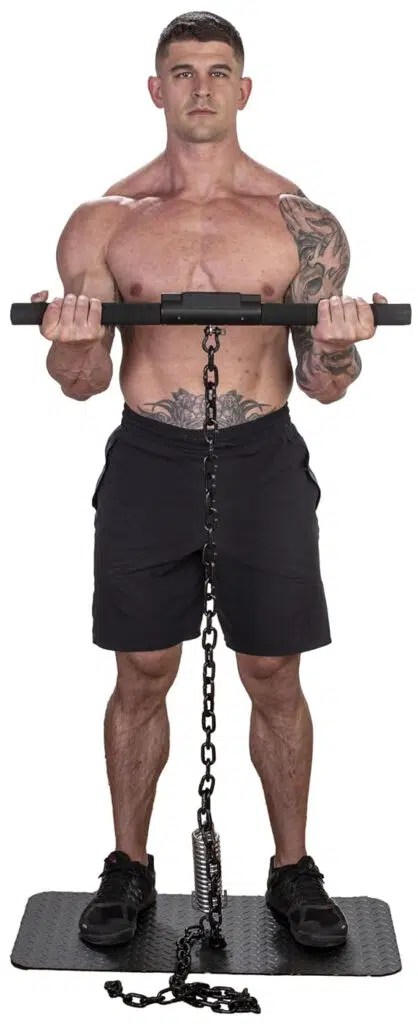Building strength can be a slow, laborious process. Except for so-called “newbie gains'” it often takes many months to increase your maximum squat, bench press, or deadlift by more than a few pounds.
Some lifters even get stuck lifting the same weights for many years. Such plateaus can be hugely frustrating, and I’ve met more than a few people who have quit lifting because of stalled progress.
As a veteran personal trainer with over three decades of experience, it’s my job to help my clients stay out of progress ruts and keep making gains. I use unique exercises and numerous programming strategies to keep my clients advancing toward their strength and fitness goals.
However, while some of my methods are quite advanced and complex, others are super simple, and almost anyone can use them to accelerate their strength gains.
In this article, I explain how to use isometrics to noticeably increase your strength in just 30 days.
A Brief Introduction to isometric Strength Training
Isometric strength training (IST) is a form of exercise where you contract your muscles without moving your joints. Well-known isometric exercises include planks and wall sits. Studies show that isometric training can be as effective as conventional lifting for building muscle size and strength, especially in untrained individuals (1, 2).
Level Up Your Fitness: Join our 💪 strong community in Fitness Volt Newsletter. Get daily inspiration, expert-backed workouts, nutrition tips, the latest in strength sports, and the support you need to reach your goals. Subscribe for free!

However, what a lot of exercisers (and some trainers) fail to appreciate is that there are two ways to do isometrics, and one is much better than the other for building strength. So, it’s critical you know how these methods differ and which one to use for your goals.
Yielding vs. Overcoming Isometrics
Yielding isometrics involve holding a weight or position for as long as possible. You remain stationary as fatigue levels start to rise and, invariably, you’ll feel your muscles start to shake and burn.
When doing yielding isometrics, you end your set when you are no longer able to support the weight or maintain your position. For some exercises, this can be several minutes. Isometric biceps holds are a good example of this type of training.
With most yielding isometric exercises, you make progress by holding your position for increasingly longer durations. For example, you may go from planking for 30 to 45 seconds. As such, yielding isometrics are an effective way to build muscle size and endurance. However, they’re not so useful for improving maximal strength.
In contrast, overcoming isometrics involves pushing or pulling against an immovable object, and sets tend to be much shorter, often just 10-15 seconds (3). Consequently, they don’t cause the same level of fatigue and burning that you get from yielding isometrics.
The key to making overcoming isometrics as effective as possible is applying maximal force to whatever immovable object you are working against. In other words, you have to pull or push like your life depends on it!
For example, while doing wall sits, instead of just waiting for fatigue to kick in, you drive your back against the wall as hard as you can, trying to push the wall over with your legs.
So, where yielding isometrics will feel like a high-rep set of conventional strength training, overcoming isometrics is more similar to attempting a new one-repetition maximum.
Consequently, they’re a very effective method for building maximal strength. However, unlike lifting heavy weights, overcoming isometrics are very safe and much more joint-friendly.
Just How Effective Are Isometrics for Building Strength?
According to one study, isometrics can increase your strength by as much as 14% in just 30 days (4). So, that means someone who can bench press 100kg / 220lb. should be able to lift 114 kg/250 lb. after a month of isometric training.
Needless to say, such an increase would be very impressive!
However, it’s important to remember that any quoted increases in strength are a cohort average, and there will be people who gained more or less than this figure. Beginners tend to experience more rapid strength gains than more experienced lifters, and age and general lifestyle also play their parts.
In addition, increases in isometric strength do not always translate pound-for-pound to improved lifting performance. Just because you can exert 20 pounds of extra force with your legs doesn’t mean your squat 1RM will jump by the same 20 pounds.
So, please take that 14% strength increase with a grain of salt. As the supplement companies say, results may vary.
All that said, in my experience, I’ve found that a month dedicated to isometric training can have a significant impact on demonstratable strength.
I’ve used isometrics in my powerlifting training and have prescribed it to many of my personal training clients. In almost every instance, diligent use of overcoming isometrics produced noticeable increases in strength in just 30 days.
30-Day Isometric Training Program
Level Up Your Fitness: Join our 💪 strong community in Fitness Volt Newsletter. Get daily inspiration, expert-backed workouts, nutrition tips, the latest in strength sports, and the support you need to reach your goals. Subscribe for free!
The program below is tried and tested and has produced excellent results for all the people I have given it to.
Do the program five times a week for one month. It’s up to you how you schedule the workouts but, ideally, you should avoid training more than three days in a row, and also avoid taking more than two back-to-back days off.
So, for example, your workout week could look like this:
- Monday – Train
- Tuesday – Train
- Wednesday – Off
- Thursday – Train
- Friday – Train
- Saturday – Train
- Sunday – Off
You’ll be doing the same isometric program each time you work out. This lack of variety is one of the reasons this program is so effective. As well as building useable muscle, it also creates stronger neural pathways, teaching how to engage your muscles more efficiently.
You’ll be doing two leg exercises, an upper body push, and an upper body pull to work all your major muscles:
- Isometric wall squat
- Isometric chest press
- Isometric leg curl
- Isometric pull-up
Perform the exercises as a slow-paced circuit. In other words, do the isometric wall squat, catch your breath, and then do the chest press. Do each exercise in turn, but never rush from one to the next. Avoid allowing cardiovascular fatigue to interfere with force production.
Regarding duration and intensity, do each exercise for 10-15 seconds while pushing or pulling as hard as you can. If you feel you can work for longer, you weren’t contracting your muscles hard enough. If in doubt, contract harder for less time rather than increase the length of your sets.
While you should try to increase the force exerted during each exercise as you get stronger, I also want you to gradually increase the volume by doing more sets as the weeks pass.
| Week 1 | 2 sets of each exercise |
| Week 2 | 3 sets of each exercise |
| Week 3 | 3 sets of each exercise |
| Week 4 | 4 sets of each exercise |
Exercise Instructions
The exercises in my 30-day isometrics program are pretty straightforward but to ensure you get the best results from each one, let’s make sure you understand how to perform all of them correctly.
Of course, make sure you start each workout with a brief warm-up comprising 5-10 minutes of easy cardio followed by dynamic mobility and flexibility exercises for all major muscles and joints.
Related: How to Warm Up for Strength Training
1. Isometric Wall Squat
The wall squat or wall sit is one of the most well-known isometric exercises. However, it’s also the one that most people do incorrectly. They lean their backs against the wall, slide down, and then just sit there for as long as possible. This is not only ineffective for building strength; it’s also incredibly boring! Let’s make sure you do this exercise the right way.
Steps:
- Stand with your back to a smooth wall and lean against it.
- Place your feet out about 18-24 inches in front of you.
- Bend your legs and slide down the wall until your thighs are parallel to the floor.
- Without holding your breath, push your lower back into the wall as hard as possible for 10-15 seconds.
- Relax and move on to the next exercise.
- Optional: Do this exercise with a booty band around your knees to increase hip abductor engagement.
2. Isometric Chest Press
The isometric chest press works your chest, shoulders, and triceps, which are the muscles you use during push-ups and bench presses. As such, your performance in both these exercises should improve over the coming month. You’ll need a long towel, a strong resistance band, or an Iso-Trainer to do this exercise.
Steps:
- Seated or standing, loop your towel/strap around your upper back.
- Adjust your grip so your upper arms are close to your sides and your hands are in front of your body.
- Without holding your breath, push forward as hard as possible for 10-15 seconds.
- Relax and move on to the next exercise.
- Optional: You can also do this exercise while lying on the floor.
3. Isometric Leg Curl
While isometric wall squats are an excellent exercise, they don’t do much for your glutes and hamstrings. Let’s fix that with some isometric leg curls. While you should contract your hammies as hard as you can, you may need to increase the force gradually as this exercise can trigger cramps in the backs of your thighs.
Steps:
- Lie on your back with your legs bent and feet about 24 inches from your butt.
- Drive your heels into the floor and lift your hips up and into extension.
- Keeping your hips raised, pull your heels in toward your butt as hard as you can for 10-15 seconds. Remember to keep breathing!
- Relax and move on to the next exercise.
- Optional: Do this exercise with a booty band around your knees to increase hip abductor engagement.
4. Isometric Pull-Up
Your final exercise works your back and biceps, and you’ll feel it in your core, too. Most trainers teach isometric pull-ups as a yielding exercise, but I have found that they’re much more effective when you do them as an overcoming exercise. While this will require a little extra effort, if you want to improve your pull-up performance, this is the way to do it.
Steps:
- Attach a strong band or strap around the bottom of your pull-up bar.
- Reach up, and grab your bar with an overhand, shoulder-width grip.
- Pull yourself up until your toes catch on your band/strap.
- Contract your arms and upper back as hard as possible for 10-15 seconds.
- Relax and then repeat the entire four-exercise routine for the prescribed number of rounds.
- Optional: You can also do this exercise with a narrower, underhand grip.
Closing Thoughts
Isometrics is an incredibly effective if criminally underutilized training method. You can use it to build stronger, bigger, more enduring muscles and, unlike some other forms of conventional strength training, it requires minimal equipment and is very easy on your joints.
Unfortunately, many people overuse yielding isometrics, which are NOT the most effective form of isometric strength training. Rather, overcoming isometrics are the best way to unlock incredible strength.
Follow the proven program in this article for 30 days and your strength levels will soar to a whole new level.
Related: Three Ways to Use Isometrics to Supercharge Your Workouts
References:
- Adams GR, Cheng DC, Haddad F, Baldwin KM. Skeletal muscle hypertrophy in response to isometric, lengthening, and shortening training bouts of equivalent duration. J Appl Physiol (1985). 2004 May;96(5):1613-8. doi: 10.1152/japplphysiol.01162.2003. PMID: 15075307.
- Oranchuk DJ, Storey AG, Nelson AR, Cronin JB. Isometric training and long-term adaptations: Effects of muscle length, intensity, and intent: A systematic review. Scand J Med Sci Sports. 2019 Apr;29(4):484-503. doi: 10.1111/sms.13375. Epub 2019 Jan 13. PMID: 30580468.
- Lum D, Barbosa TM. Brief Review: Effects of Isometric Strength Training on Strength and Dynamic Performance. Int J Sports Med. 2019 May;40(6):363-375. doi: 10.1055/a-0863-4539. Epub 2019 Apr 3. PMID: 30943568.
- Spiering, Barry A.1; Clark, Brian C.2,3; Schoenfeld, Brad J.4; Foulis, Stephen A.1; Pasiakos, Stefan M.1. Maximizing Strength: The Stimuli and Mediators of Strength Gains and Their Application to Training and Rehabilitation. Journal of Strength and Conditioning Research 37(4):p 919-929, April 2023. | DOI: 10.1519/JSC.0000000000004390










